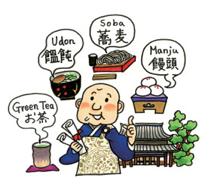Hakata Culture vol.17
Did you know that udon, soba and manju all originated in Hakata?

The hottest season is at its peak, and the best thing to help cool you off and recharge may be a bowl of chilled noodles. Udon and soba are delicious and nutritious... but did you know that they both originated in Hakata?
Jyotenji Temple, which was built in 1242 and is located in Hakata 1-chome, is where the famous Hakata Gion Yamakasa festival originated. A stone memorial that reads: 'Udon Soba Hassho no Chi'' (the place where udon and soba were first made) can be found. The monk Shoichikokushi (founder of Jyotenji Temple), upon returning from China in 1241, is said to have brought back the craft of making powder for the purpose of making noodles. At that time many monks travelled from Hakata (Nanotsu) to China, receiving training in various arts and techniques, and then bringing them back to Japan. Thanks to the adoption of these methods of noodle powder refinement, the making udon, soba, and manju spread throughout Japan.
As for manju, it is said that when Shoichikokushi was walking around Hakata during his takuhatsu (a type of training for monks where they go door to door gathering small donations of food, and blessing those who kindly complied), he taught his noodle powder craft to a generous tea stand owner. The owner adopted the precious recipes for making steamed amazake manju (manju made with sweet sake) and yokan (sweets made with bean paste). Both sweets became well-known throughout the country as sado (Japanese tea ceremony) grew in popularity during the Kamakura and Muromachi eras.
Green tea was first brought to Hakata too! It is said that Yousai, founder of the oldest Zen temple in all of Japan, Shofukuji (built in 1190), brought back tea seeds and planted them in Sefuri mountain. He is called chaso, meaning 'the first one who brought tea'.
These temples, Jyotenji and Shofukuji, are only a few minutes walk from Taihakudori in front of Hakata Station. There are also many other shrines and temples around Fukuoka with wonderful legends and beautiful gardens. As summer cools down and fall deepens in color, please take in the history of Kyushu through its food, shrines, and culture!
A public relations manager
Kimiyo Sasaki
うどんも、そばも、まんじゅうも博多発祥って知っていましたか?
残暑厳しい中、食欲が今ひとつ…という人でも食べたくなるのが麺類。特に、うどんとそばは冷たいものでも温かいものでも人気です。その「うどん・そば」が博多発祥って知っていました?
博多祇園山笠発祥のお寺としても知られる博多駅前1丁目にある「承天寺」(1242年)の境内には「饂飩蕎麦発祥之地」という石碑が建っているのです。承天寺を開いたお坊さん・聖一国師は仁治2年(1241年)に中国から帰国した際に、製粉の技術を持ち帰ったといわれます。当時は、多くの僧侶たちが博多(那の津)から仏教修行のために中国へ旅立ち、教典とともに多くの書物と技術を持ち帰ったのです。このおかげで、きめ細かい粉が作られるようになり「饂飩・蕎麦・饅頭」などの粉物食文化が全国に広まっていったのでしょう。
饅頭も、聖一国師が博多の町を毎日托鉢して歩いていたときに、親切にしてくれた茶店の主人に製法を教えたと伝えられています。教えた饅頭は「甘酒饅頭」で蒸したもの。また羊羹の作り方も伝えたそうで、中世(鎌倉、室町時代)茶道の発展とともに饅頭も羊羹も広がりました。2008年には饅頭発祥の碑も建てられています。
ちなみにお茶も博多に最初に伝わっています。日本最古の禅寺「聖福寺」(1190年)を開いた栄西禅師が茶種を持ち帰り、背振山に植えたのが最初といわれ「茶祖」と呼ばれました。
これら承天寺、聖福寺は博多駅から大博通りを歩いて数分のところにあります。他にもいわれのある寺社仏閣が多数あり、境内や庭園の樹木も大きく、秋も深まると見事に色づいた景色を見せてくれます。食べながら歩きながら、博多の歴史に触れてください。
*托鉢
出家者の修行の一つで、家々を回り最低限の食糧をもらうもの。この行為は民に功徳を積ませるため。
福岡市広報課長 佐々木 喜美代

